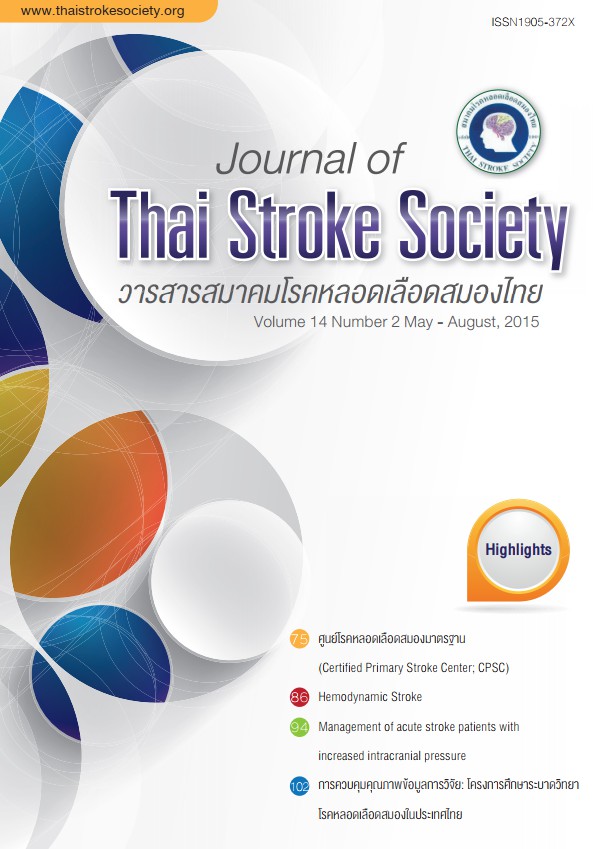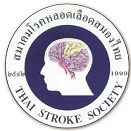Hemodynamic stroke
Keywords:
hemodynamic, stroke, watershed infarction, cerebral hypoperfusion, systemic failureAbstract
Hemodynamic stroke is the cerebral ischemia caused by cerebral hypoperfusion. This may be the results of systemic hypoperfusion state or cerebral vascular disorders such as severe ICA or CCA or VA stenosis or occlusion with cerebral hemodynamic compromised. Most of the signs and symptoms of hemodynamic stroke did not differ from stroke due to other causes. But there are some aspects that are common in hemodynamic stroke, such as limb shaking TIA and the fluctuation of symptoms. The diagnostic tests are mainly radiologic imaging studies. The studies aim to define cause of cerebral ischemia, the feature of cranial arteries and measurement of cerebral perfusion, which contains several methods such as CT / MRI brain, CT angiogram, MR angioram, digital subtraction angiogram and perfusion CT/MRI. The treatment of hemodynamic stroke based on correction the cause of hemodynamic failure and correct the vascular pathological potential causing decrease in cerebral perfusion pressure and poor collateral circulation.
References
cases. Brain 1966;89:235-268.
Brierley JB, Prior PF, Calverley J,et al. The pathogenesis of ischaemic neuronal damage along the cerebral arterial boundary zones in Papio anubis. Brain
1980;103:929-965.
Baron JC, Bousser MG, Comar D,et al.Noninvasive tomographic study of cerebral blood flow and oxygenmetabolism in vivo. Potentials, limitations, and
clinical applicationsin cerebral ischemic disorders. Eur Neurol 1981; 20: 273-284.
Moustafa RR., Izquierdo-Garcia D, Jones PS,et al. Watershed Infarcts in Transient Ischemic Attack/Minor Stroke With 50% CarotidStenosis: Hemodynamic
or Embolic? Stroke. 2010;41:1410-1416.
Castaigne P, Lhermitte F, Gautier JC, et al.Internal carotid artery occlusion: a study of 61 instances in50 patients with post-mortem data. Brain 1970; 93: 231-
258.
Barnett HJM, Peerless SJ, Kaufmann JCE. “Stump” of internal carotid artery—a source for further cerebral embolic ischemia. Stroke 1978; 9: 448-456.
Georgiadis D, Grosset DG, Lees KR. Transhemispheric passage of microemboli in patients with unilateral internal carotid artery occlusion. Stroke 1993; 24:
1664-1666.
Grubb RL Jr, Derdeyn CP, Fritsch SM, et al. Importance of hemodynamic factors in the prognosis of symptomatic carotid occlusion. JAMA 1998; 280: 1055-1060.
Yamauchi H, Fukuyama H, Nagahama Y, et al. Signifi cance of increased oxygen extraction fraction in fi ve-year prognosis of major cerebral arterial occlusive diseases. J Nucl Med 1999; 40: 1992-1998.
Hankey GJ, Gubbay SS. Focal cerebral ischaemia and infarction due to antihypertensive therapy. Med J Aust 1987; 146: 412-414.
Gottesman RF, Sherman PM, Grega MA, et al. Watershed strokes after cardiac surgery: diagnosis, etiology, and outcome. Stroke 2006;37: 2306-2311.
Shahar A, Sadeh M. Severe anemia associated with transient neurological deficits. Stroke 1991; 22: 1201-1202.
Kim JS, Kang SY. Bleeding and subsequent anemia: a precipitant for cerebral infarction. Eur Neurol 2000; 43: 201-208.
Bogousslavsky J, Regli F. Unilateral watershed cerebral infarcts. Neurology.1986;36:373-377.
Bladin CF, Chambers BR. Clinical features, pathogenesis, and computed tomographic characteristics of internal watershed infarction. Stroke.1993;24:1925-1932.
Brown MM, Wade JP, Bishop CC,et al. Reactivity of the cerebral circulation in patients with carotid occlusion. J Neurol NeurosurgPsychiatry. 1986;49:899–904.
Dobkin BH. Orthostatic hypotension as a risk factor for symptomatic occlusive cerebrovascular disease. Neurology 1989; 39: 30–34.
Ross RW, Page NGR. Critical perfusion of brain and retina. Brain 1983; 106: 419-434.
Niehaus L, Neuhauser H, Meyer BU. Transient visual blurring,retro-orbital pain and repetitive involuntary movements in unilateral carotid artery occlusion. Clin
Neurol Neurosurg 1998;100: 31–32.
Klijn CJM, Kappelle LJ, van Huff elen AC, et al. Recurrent ischemia in symptomatic carotid occlusion: prognostic value of hemodynamic factors. Neurology
2000; 56: 1806-1812.
Tatemichi TK, Desmond DW, Prohovnik I, et al. Dementia associated with bilateral carotid occlusions: neuropsychological and haemodynamic course after
extracranial to intracranial bypass surgery. J Neurol Neurosurg Psychiatry 1995; 58: 633-636.
Bakker FC, Klijn CJ, Jennekens-Schinkel A,et al. Cognitive impairment in patients with carotid artery occlusion and ipsilateral transient ischemic attacks. J
Neurol 2003; 250: 1340-1347.
Momjian MI, Baron JC. The pathophysiology of watershed infarction in internal carotid artery disease: review of cerebral perfusion studies. Stroke 2005; 36:
567-577.
Del Sette M, Eliasziw M, Streifl er JY, et al. Internal borderzone infarction: a marker for severe stenosis in patients with symptomatic internal carotid artery
disease. Stroke 2000; 31: 631-636.
Bladin CF, Chambers BR. Clinical features, pathogenesis, and computed tomographic characteristics of internal watershed infarction. Stroke 1993; 24: 1925-1932.
Mangla R, Kolar B, Almast J,et al.Border Zone Infarcts: Pathophysiologic and Imaging Characteristics. RadioGraphics 2011; 31:1201–1214
Nemoto EM, Yonas H, Kuwabara H, et al. Identification of hemodynamic compromise by cerebrovascular reserve and oxygen extraction fraction in occlusive
vascular disease J Cereb Blood Flow Metab 2004; 24: 1081-1089.
Smith LMcG, Elkins JS, Dillon WP,et al. Perfusion-CT assessment of the cerebrovascular reserve: a revisit tothe acetazolamide challenges. J Neuroradiol 2008; 35: 157-164.
Bokkers RP, Bremmer JP, van Berckel BN, et al. Arterial spin labeling perfusion MRI at multiple delay times: a correlative studywith H215O positron emission tomography in patients with symptomatic carotid artery occlusion.J Cereb Blood Flow Metab 2009; 30: 222-229.
Rutgers DR, Klijn CJM, Kappelle LJ,et al. Sustained bilateral hemodynamic benefi t of contralateral carotid endarterectomy in patients with symptomatic
internal carotid artery occlusion.Stroke 2001; 32: 727-734.
Yoshimoto T. Use of cerebrovascular reactivity in patients with symptomatic major cerebral artery occlusion to predict 5-year outcome: comparison of xenon-133 and iodine-123-IMP singlephoton emission computed tomography. J Cereb Blood Flow Metab 2002; 22: 1142-1148.
Smith LMcG, Elkins JS, Dillon WP, Schaeff er S,et al.Perfusion-CT assessment of the cerebrovascular reserve: a revisit tothe acetazolamide challenges. J Neuroradiol 2008; 35: 157-164.
Bokkers RP, Bremmer JP, van Berckel BN, et al. Arterial spinlabeling perfusion MRI at multiple delay times: a correlative studywith H215O positron emission tomography in patients with symptomatic carotid artery occlusion.J Cereb Blood Flow Metab 2009; 30: 222-229.
Tanya NT, George C, Michael JL,et al. Relationship Between Blood Pressure and Stroke Recurrence in Patients With Intracranial Arterial Stenosis. Circulation 2007;115:2969-2975.
Bruce O, Hans CD, Salim Y,et al.Level of Systolic Blood Pressure Within the Normal Range and Risk of Recurrent Stroke. JAMA 2011;306:2137-2144.
Rothwell PM, Howard SC, Spence JD. Relationship Between Blood Pressure and Stroke Risk in Patients With Symptomatic Carotid Occlusive Disease. Stroke 2003; 34:2583-2590.
EC/IC Bypass Study Group. Failure of extracranialintracranial arterial bypass to reduce the risk of ischemic stroke. Results of an international randomized trial. N Engl J Med 1985; 313: 1191–200.
Fluri F, Engelter S, Lyrer P. Extracranial-intracranial arterial bypass surgery for occlusive carotid artery disease. Cochrane Database Syst Rev 2010; 2: CD005953.
Rutgers DR, Klijn CJM, Kappelle LJ,et al. Sustained bilateral hemodynamic benefi t of contralateral carotid endarterectomy in patients with symptomatic
internal carotid artery occlusion. Stroke 2001; 32: 727-734.
Downloads
Published
How to Cite
Issue
Section
License
ข้อความภายในบทความที่ตีพิมพ์ในวารสารสมาคมโรคหลอดเลือดสมองไทยเล่มนี้ ตลอดจนความรับผิดชอบด้านเนื้อหาและการตรวจร่างบทความเป็นของผู้นิพนธ์ ไม่เกี่ยวข้องกับกองบรรณาธิการแต่อย่างใด การนำเนื้อหา ข้อความหรือข้อคิดเห็นของบทความไปเผยแพร่ ต้องได้รับอนุญาตจากกองบรรณาธิการอย่างเป็นลายลักษณ์อักษร ผลงานที่ได้รับการตีพิมพ์ในวารสารเล่มนี้ถือเป็นลิขสิทธิ์ของวารสาร





